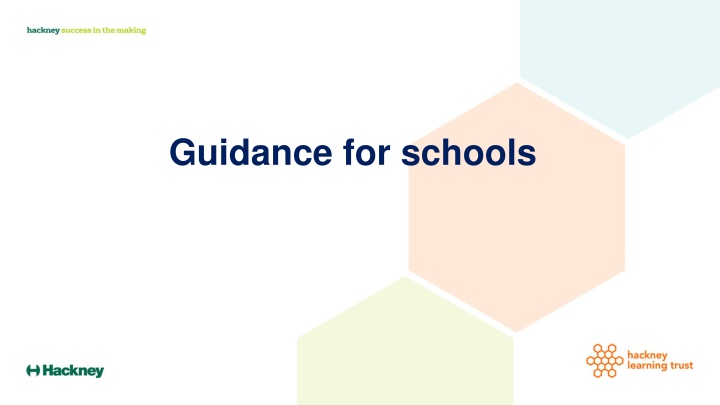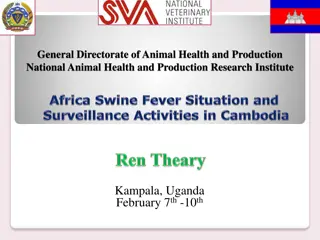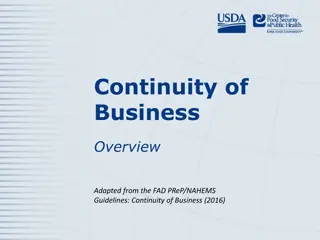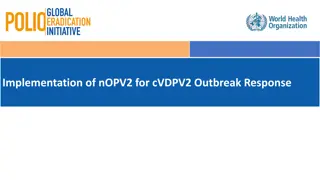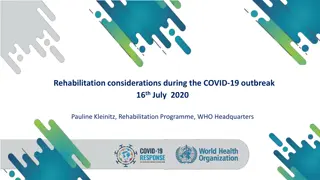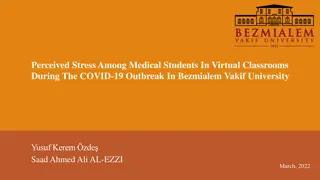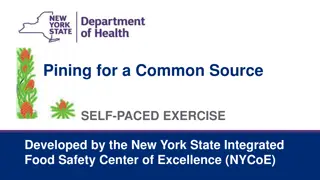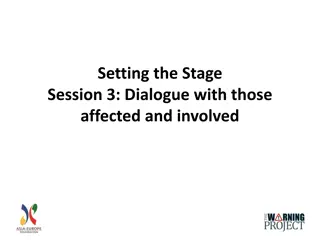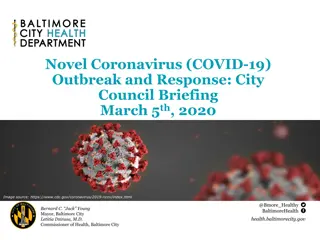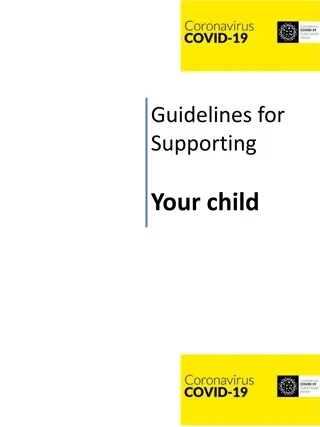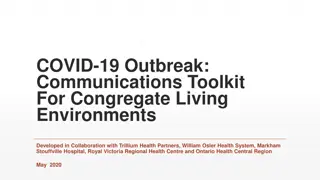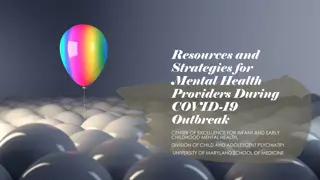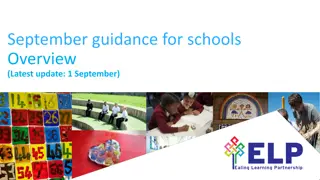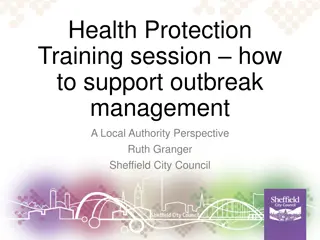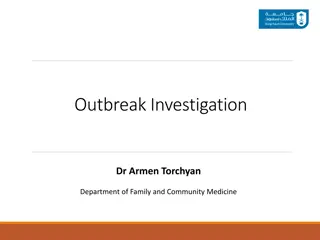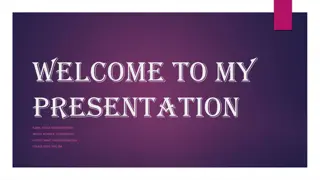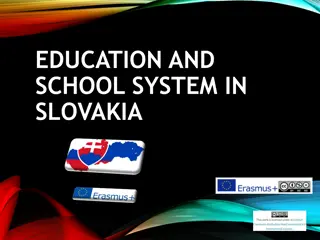Guidance for Schools During COVID-19 Outbreak: Updated Measures
Prevalence of Covid-19 has decreased, prompting the update on measures for schools and childcare providers. The guidance covers a range of aspects including creating a safe learning environment, balancing risks, and minimizing educational impact. Schools are vital for public health services and safeguarding, emphasizing the importance of maintaining a full educational experience for children while implementing necessary protective measures. The guidance outlines processes, controls, and planning considerations to ensure safety and continuity of education during the ongoing pandemic.
Download Presentation

Please find below an Image/Link to download the presentation.
The content on the website is provided AS IS for your information and personal use only. It may not be sold, licensed, or shared on other websites without obtaining consent from the author.If you encounter any issues during the download, it is possible that the publisher has removed the file from their server.
You are allowed to download the files provided on this website for personal or commercial use, subject to the condition that they are used lawfully. All files are the property of their respective owners.
The content on the website is provided AS IS for your information and personal use only. It may not be sold, licensed, or shared on other websites without obtaining consent from the author.
E N D
Presentation Transcript
DfE Actions for early years and childcare providers during the COVID-19 outbreak Guidance updated 02.07.20 DfE guidance on the full opening of schools covers all phases including expectations for children with SEND and those with EHCPs in the mainstream Separate guidance is available for Early Years, Further Education Colleges and Special Schools DfE guidance has been prepared with input from school leaders, unions and sector bodies. PHE and the Health and Safety executive. Schools are expected to work closely with parents, staff and unions when agreeing the best approaches for their own circumstances The guidance is in five sections It will be updated! 2
Introduction Welcoming children back - Why this, why now Prevalence of Covid-19 has decreased NHS track and trace is up and running (apparently) We are clear about the measures needed to create a safe learning environment - risk to children becoming severely ill is very low Schools are a vital point of contact for public health and safeguarding services that are critical to the well being of children and families The negative impact of children missing school and education academically, socially and emotionally The widening of the educational attainment gap will impact of the future lives of children the longer schools are only partially open ONS analysis suggests staff working in schools tend not to be at any greater risk than many occupations What is being asked of schools and school leaders Whilst Covid-19 remains, judgements will need to be made at a local school level about how to balance and minimise risks and provide children a full educational experience by implementing propionate protective measures Schools need to use existing resources as there are no plans at present to reimburse additional costs Schools will also need to plan for the possibility of a local lockdown and how they will ensure continuity of education Purpose of the guidance To set out the PHE guidance schools must follow to minimise risk using the PHE endorsed system of controls in conjunction with a revised risk assessment creating an inherently safer environment for children and staff Processes that must be followed should anyone develop coronavirus symptoms Systems and controls as laid out are essential and all schools must cover them all but how will differ based on individual circumstances Important to note: Where something is essential for public health reasons, as advised by PHE, we have said must . Where there is a legal requirement we have made that clear. This guidance does not create any new legal obligations. 3
Section 1: Public health advice to minimize coronavirus (COVID-19) risks Essential measures include: The guidance states A requirement people who are ill stay at home Robust hand and respiratory hygiene Enhanced cleaning arrangements Active engagement with NHS Test and Trace Formal consideration of how to reduce contacts and maximise distancing between those in school wherever possible and minimise potential for contamination so far as is reasonably practicable How contacts are reduced will depend on the school s circumstances and will (as much as possible) include: o Grouping children together o Avoiding contact between groups o Arranging classrooms with forward facing desks o Staff maintaining distance from pupils and other staff as much as possible It is the expectation that all pupils return at the start of term full time including school based nurseries Schools should not put in place rotas. Schools must comply with health and safety law requiring them to assess the risk and put proportional measures in place to minimise the risk It is a legal requirement to revisit and update your risk assessment also considering wider risk assessments Schools may wish to include the essential measures and the system of controls as a basis of their risk assessments The guidance expands in more detail on the System of Controls and Essential measures 4
Points to consider and implement (1/2) How to group children It is recognised that Children, especially the youngest, cannot socially distance form each other or staff so the grouping of children provides a protective measure Small groups restricts the normal operation of schools so the size of groups and bubbles need to be increased At Primary and possibly key stage 3, schools may be able to limit group sizes to a class but if this is not compatible with the delivery of a full curriculum or presents an unreasonable logistical challenge they can look to implement year group bubbles For key stage 4 and 5 the groups may need to be the size of a year group to enable schools to deliver the full curriculum Approaches of separating groups and maintaining distance are not all or nothing options and will both bring benefits if only implemented partially Teachers and staff can operate across classes and year groups in order to facilitate the delivery of the school timetable, keeping socially distanced where possible but this should not limit a full educational offer Measures in the classroom and elsewhere Where circumstances allow adults should stay 2 metres apart from other adults and minimise face to face contact within 1 metre from anyone For children old enough they should be encouraged to maintain reasonable distance and not touch staff or peers Children with complex needs who need close contact should be provided for as normal Seating children side by side and facing forward is considered a protective measure When arriving and leaving schools may consider staggering start and finish times Schools should have a process for the removal of face coverings when adults and children arrive at school 5
Points to consider and implement (2/2) Other considerations Supply and peripatetic teachers, therapists and clinicians can work across schools and should provide interventions as usual Where pupils and staff can have their own equipment they should do so, however shared equipment, books, games etc. can be shared within a group or bubble Outdoor equipment can be used but cleaned frequently, this includes equipment used in wraparound care PPE but only when necessary (guidance remains as before) Majority of staff will not require PPE Use only when a child or young person becomes ill and 2 meter distance cannot be maintained Where routine intimate care already involves the use of PPE Response to any infection Understand and engage with the NHS test and trace process Manage confirmed cases amongst the school community Contact local health protection team who will work with the school to guide them through the action they need to take and provide definitive advice on who should be sent home. Template letter may be provided to schools on advice of the PHT to send to parents and staff if needed Schools should not request negative test results or other medical information before allowing pupils or staff to return If a wider outbreak in a school is confirmed, in consultation with the local Director of Public Health, a mobile testing unit may be dispatched to test first a class, followed by year group or whole school if necessary Alternative Provision It is the intention that all pupils in alternative provision (AP) will return full time in the Autumn term using the system of controls and guidance for mainstream schools. APs may wish to adopt whole school bubbles to meet the needs of their pupils. 6
Section 2: School operations Transport Dedicated school transport, including statutory provision Can take many forms involving different types of transport and different systems of collecting and transporting children so the precise approach taken will need to reflect a reasonable range of measures in different circumstances Guidance differs from advice for passengers on public transport Should align with the principals underpinning the system of controls as outlined in section 1 of the guidance Requires partnership working between local authorities, schools, trusts and dioceses Further guidance will be published to local authorities Wider public transport Schools should work with pupils and families to keep the use of public transport to a minimum, particularly at peak times encouraging walking and cycling Local authorities will be working with the Department of Transport and schools on a range of measures and approaches to support safer travel to school 7
Attendance Attendance From autumn 2020 the usual rules on attendance will apply covering: Parental duty to ensure a child attends regularly Schools responsibilities to record attendance and absence The use of sanctions and PCNs in line with the LA codes of conduct In relation to pupils who are shielding or self isolating it should be noted that shielding advice for adults and children will pause on 1stAugust. Advice to shield may return if rates of the disease rises in local areas Where pupils are unable to attend school on medical advice they should immediately be offered access to remote education Schools should work with pupils and families who are anxious about returning to school, putting support and protective measures in place to ensure they are able to do so Schools and local authorities are asked to Communicate clear expectations about attendance though out the summer ahead of the new school term Identify and engage with pupils and families who may be anxious or reluctant including disadvantaged or vulnerable children Use the additional catch-up funding Work with other services and professionals including social services to ensure attendance 8
Workforce (1/2) Return to work The guidance is very clear and states that where schools apply the protective measures outlined in the guidance and in line with health and safety and equalities duties, risk to all staff will be mitigated including for those who are extremely clinically vulnerable and clinically vulnerable and as such it is expected that this will allow the vast majority of staff to return to the work place. School leaders should try as far as practically possible to accommodate additional measures where appropriate Governors and school leaders should have due regard to work life balance and well being and can use the resources available to support this work Extra mental health support for pupils and teachers Education Support Partnership Workload reduction toolkit Staff deployment Staff may need to be deployed differently and this should be discussed and agreed with individuals Teaching assistants and specialist staff from within and outside a school can work with pupils in different groups, classes and year groups particularly in supporting pupils with SEND Teaching assistants where directed and supported by a teacher may be deployed to lead groups or cover lessons (see guidance for detail) Supply staff and temporary staff can move between schools but must comply with the schools arrangements for mitigating risk Recruitment should continue as usual with due regard to KCSIE and legal requirements regarding pre-employment checks. NQTs should be supported to prepare and schools should make use of the early career framework reforms 9
Workforce (2/2) The rest of this section covers ITT trainees - there is a lack if school places and demand is high , schools might consider taking and ITT trainee to build capacity. The guidance outlines a range of ways how ITT trainees could be deployed flexibly Staff taking leave Use of volunteers Safeguarding and the revision of a schools child protection policy in line with keeping children safe in education and should refer to the coronavirus (COVID-19): safeguarding in schools, colleges and other providers guidance Catering school kitchens should be fully operational form the start of the autumn term and normal legal requirements apply to the provision of food to all pupils who want it including for those eligible for benefits-related free school meals or universal infant free school meals. School kitchens can continue to operate, but must comply with the guidance for food businesses on coronavirus (COVID-19) Estates brief guidance on pre term checks and minor adjustments and adaptations that may be required. Don t forget your legionella testing Legionella risks during the coronavirus outbreak Educational visits - not residential, stay local, try and be outside, do your risk assessments health and safety guidance on educational visits School uniform encouraged to return to usual uniform policies but be flexible and be aware of families who may be experiencing financial difficulties Extra-curricular provision and wrap around care schools should consider resuming breakfast and afterschool club provision 10
Section 3: Curriculum, behaviour and pastoral support Key principles - Education is not optional Teach an ambitious and broad curriculum in all subjects from the start of the autumn term, but make use of existing flexibilities to create time to cover the most important missed content Aim to return to the school s normal curriculum in all subjects by summer term 2021 Plan on the basis of the educational needs of pupils Develop remote education so that it is integrated into school curriculum planning The guidance contains specific detail and points for each key stage Physical activity Outdoor sports a priority Schools should refer to the following advice: guidance on the phased return of sport and recreation and guidance from Sport England for grassroots sport advice from organisations such as the Association for Physical Education and the Youth Sport Trust Schools are able to work with external coaches, clubs and organisations Catch up support Reference made to previous information and guidance regarding the one off grant and National Tutoring Programme 11
Curriculum, behaviour and pastoral support Pupil wellbeing and support Reference to previously published guidance and resources Supporting pupil and student mental wellbeing The Whole School SEND consortium will be delivering some training and how-tos for mainstream school teachers. Details of future training sessions are held on the events page of the SEND Gateway DfE has also published the first of the relationship, sex and health education training modules for teachers to support them in preparation to deliver content on mental health and wellbeing. Training module on teaching about mental wellbeing Schools and school nurses need to work together to ensure delivery of the healthy child programme (which includes immunisation), identifying health and wellbeing needs Behaviour expectations Consider updating and reviewing behaviour policies, communicate clearly to staff, pupils and families ensuring they are reasonable and proportionate Behaviour and discipline in schools The disciplinary powers that schools currently have, including exclusion, remain in place and must be consistent with the relevant legislation 12
Section 4: Assessment and accountability (1/2) Inspection For state-funded schools, routine Ofsted inspections will remain suspended for the autumn term During the autumn term, inspectors will visit a sample of schools to discuss how they are managing the return to education of all their pupils These will be collaborative discussions, taking into account the curriculum and remote education expectations set out in this guidance, and will not result in a judgement It is intended that routine Ofsted inspections will restart from January 2021, with the exact timing being kept under review Primary assessment Primary assessments will take place in summer 2021. The early years foundation stage profile, and all existing statutory key stage 1 and 2 assessments, should return in 2020 to 2021 in accordance with usual timetables. This includes: The phonics screening check Key stage 1 tests and teacher assessment Year 4 multiplication tables check Key stage 2 tests and teacher assessment 13
Section 4: Assessment and accountability (2/2) Exams GCSEs and A levels will take place in summer 2021 with adaptations, including those which will free up teaching time. Ofqual will launch a consultation on proposed adaptations to exams shortly Announced that there will be an opportunity for students to sit exams in the autumn Centre responsibility for autumn GCSE, AS and A level exam series Accountability Performance tables are suspended for the 2019 to 2020 academic year, and no school or college will be judged on data based on exams and assessments from 2020 More information is set out at coronavirus (COVID-19): school and college accountability. 14
Section 5: Contingency planning for outbreaks This section will be expanded in due course and schools will work with the local authority who will, in turn, work with the DfE to make decisions locally. The Contingency plans for outbreaks sections pays strong regard to the provision of remote education support. Together with the reference in the Inspection section it is clearly an area schools need to pay attention to. It sets out clear and robust expectations with reference to existing guidance and resources Schools may have to close and remain open only for vulnerable children and the children of critical workers, and providing remote education for all other pupils. Schools should read this section in full and plan accordingly 15
Annex A: Health and safety risk assessment The appendix outlines guidance on reviewing and updating your school current covid-19 risk assessment in line with section 1 of the guidance . General information on how to make a workplace COVID-secure, including how to approach a coronavirus (COVID-19) risk assessment, is provided by the HSE guidance on working safely. It also outlines how schools should Share the results of their risk assessment with their workforce. If possible, they should consider publishing it on their website to provide transparency of approach to parents, carers and pupils (HSE would expect all employers with over 50 staff to do so) there is general guidance on consulting and involving employees Monitor and review regularly taking action where needed Explicit guidance on an employers roles and responsibilities Health and safety: responsibilities and duties for schools, The role of school leaders - who does what , FAQs section Resolving issues and concerns, working with unions and raising concerns with the HSE 16
Early years and childcare DfE Actions for early years and childcare providers during the COVID-19 outbreak Guidance updated 02.07.20 Updated guidance applies from 20.07.20 in relation to the groups approach in early years. Key changes are covered below: (Section 2.1) Settings will no longer be required to keep children in small consistent groups, but should still consider how to minimise mixing (3.1) Settings should thoroughly review risk assessments with the updated approach (3.2) Use the review of disparities in risks and outcomes report to understand increased risk factors (3.3) Updated system of controls set out with details on 9 protective measures (4) Updated content on attendance for those shielding as the advice for adults and children will be paused from 01.08.20; removal of content on vulnerable children as settings will be open to all children (5.3) Registered wraparound providers are able to operate in school or early years settings. From 04.07.20 wraparound care providers in other settings can also open (7.6) EYFS reforms are voluntary in primary schools in 20/21 and statutory in 21/22 (7.7) The new Reception Baseline Assessment has been postponed to 21/22 17
Special schools and other specialist settings (1/2) DfE Guidance for full opening: special schools and other specialist settings Guidance published 02.07.20 Guidance follows a similar format to the schools full opening (above) and most wording is exactly the same. Key points/adaptations for special schools include: Recognition special schools face specific challenges with social distancing and bubbles, as well as the heightened importance of coproduction and consultation Risk assessments will need to reflect additional needs for CYP with EHCPs; individual RAs are not required but where used should be produced with parents The temporary changes to SEND legislation are restated there is no change here Adapted wording on cleaning hands to recognise the context in special schools Recognition maintaining distance or forming bubbles is more difficult, but lower numbers overall should help to limit the number of contacts for any individual Settings will need to assess the cleanability of equipment used in the delivery of therapies to check if it can be disinfected between each use All pupils in hospital schools should also be able to return full time Dedicated school transport should follow similar principles as on site. DfE will shortly publish new guidance to LAs, including support to reduce use of public transport Attendance CYP with EHCPs will need preparation for their return, which might include visits to school, social stories and other approaches 18
Special schools and other specialist settings (2/2) DfE Guidance for full opening: special schools and other specialist settings Guidance published 02.07.20 Recognition staff deployment is more complex in special schools schools and LAs may wish to have discussions over the summer about e.g. training additional specialist staff or settings working together to offer each other resilience There is no expectation CYP with an EHCP will need to repeat a year or remain in education any longer than originally set out in the EHCP; a very few exceptions may be made which would likely be an individualised programme for a half / full term Delivering remote education may be more challenging but should be done with parents and carers and using specialist inputs where required e.g. to design a speech and language intervention parents can deliver at home Oak National Academy will provide specialist content for pupils with SEND in addition to DfE s list of online resources for children with SEND 19
Ofqual-GCSE, AS and A level assessment in 2021 Ofqual Proposed changes to the assessment of GCSEs, AS and A levels in 2021 Open consultation published 02.07.20 Ofqual is consulting on a number of detailed proposals for 2021 exam and assessment requirements, including: Adaptations in a number of subjects to give more time to cover the full content. This will include: observing practical science work; assessing art and design on the portfolio alone; not recording spoken language assessment in GCSE English language Making adaptations now in case public health safeguards don t allow for activities or assessments e.g. GCSE drama watching a recorded performance and not expecting D&T students to use machinery themselves Exploring content sampling and use of optional questions in non-core subjects (ie English literature, language, mathematics and sciences) Asking exam boards to consider how the 2021 exam timetable could be delayed to allow more time for teaching, in particular whether GCSEs could start after half term on 07.06.21 The consultation closes at 11.45pm on 16.07.20 respond here 20
